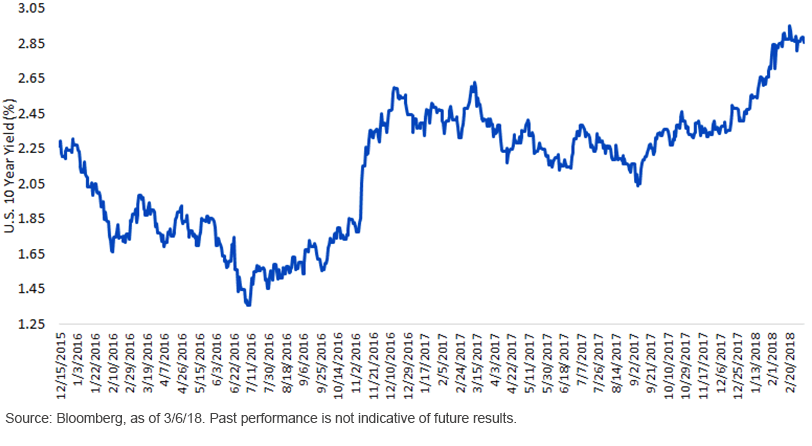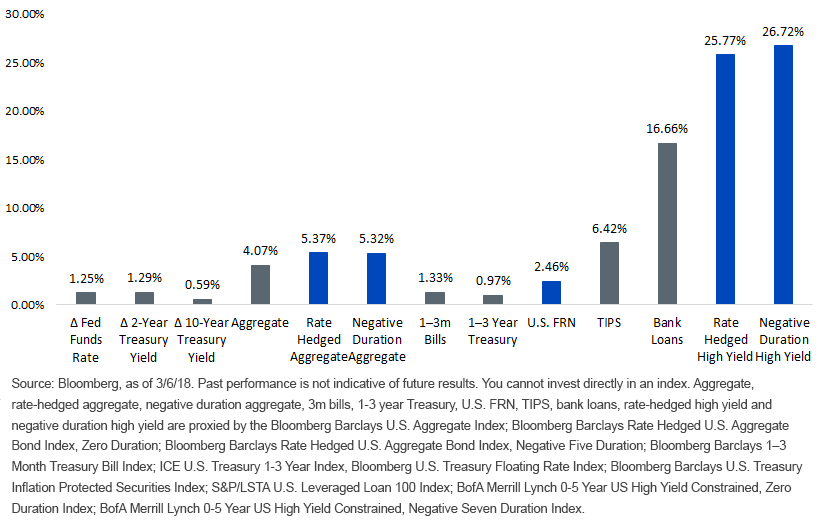The Impact Of Fed Rate Hikes On Core Fixed Income
While fixed income strategists have called for rising rates in nearly every year since the financial crisis, 2018 has marked one of the worst starts for bond investors since 1996.1 With 10-year rates up more than 45 basis points (bps), many investors are questioning what if any changes they should be making to their portfolios. Central to this decision is their view on inflation and Federal Reserve (Fed) policy. In this piece, we examine the impact on U.S. interest rates and fixed income returns since the Fed started tightening in December 2015.
Rising Rates Where?
Despite hiking the Federal Funds Rate five times, U.S. 10-year bond yields have spent much of their time lower than where they started. In our view, this has primarily been a function of the outlook for global growth along with inflation. With expectations for both forecasts to rise in 2018, longer-term bond yields around the world have started to take note.
U.S. 10-Year Yield, 12/15/15–3/6/18

With rates at their highest levels since 2014, the recent pause has many wondering if we’re poised to retrace or move higher. While hardly a stretch, we’re inclined to believe that we may have seen the cycle low in U.S. interest rates. As higher bond yields generally imply poor returns for fixed income, the gradual rise in rates (until recently) has meant that most investors have been able to avoid negative total returns. In the chart below, we highlight a variety of ways investors can reduce their exposure to rising rates.
Historically, investors could reduce legacy fixed income positions and increase exposure to cash, shorter-duration fixed income or floating rate strategies. As we highlighted back in 2013, traditional approaches to rising rates often involve trade-offs. Below, we contrast these traditional approaches with the Indexes in WisdomTree’s rising rates suite.
Impacts of Fed Rate Hikes on Fixed Income Returns, 12/15/15–3/6/18

Short-Maturity Strategies
While many investors have sought to invest in short-maturity fixed income as a way to reduce exposure to rising rates, an approach that we really believe in is focused on investing in floating rate notes from the U.S. Treasury. In this strategy, investors have zero exposure to corporate credit risk but are able to see the coupon rate of their investments rise along with short-term bill yields. This approach has doubled returns of 1- to 3-month Treasury bills as short rates rose. Given that floating rate notes have a duration equal to the frequency of their reset,2 they have not experienced the negative total returns experienced by 1- to 3-year maturity Treasuries. At current levels, it’s possible that investors begin to experience negative holding period returns as soon as the beginning of April. Just because an investment has low-interest rate risk doesn’t necessarily mean that it can’t underperform as short rates rise. In our view, this is one of our favorite ways to play a slightly more hawkish Fed.
Aggregate Strategies
In WisdomTree’s approaches to the Agg, we worked with Bloomberg Barclays to construct a strategy that maintains exposure to the same core bonds in their portfolio but seeks to reduce exposure to interest rate risk by selling offsetting positions in Treasury futures contracts to hedge risk. Since the Fed started tightening, hedging has led to an additional 1.37% in returns, net of the cost of hedging. For more aggressive investors who are seeking to profit from rising rates, our negative duration approach “overhedges” the bond portfolio to achieve a target duration of -5 years. Since this approach exposes investors to a flattening yield curve, gains from negative duration have been partially offset by losses as short-term rates rose faster than long-term rates despite recent outperformance.
High Income, Low Duration
One approach that has gained a significant amount of assets over the last several years has been bank loan strategies. While the headline of high income, low-interest-rate risk seems great, performance has meaningfully lagged WisdomTree’s approaches to high yield. Similar to our thinking with aggregate strategies, if investors can maintain exposure to bonds, but then hedge or “overhedge” their portfolios, they’re able to maintain a consistent approach to fixed income while reducing interest rate risk. While rate-hedged high-yield strategies have been more volatile, they’ve meaningfully outperformed by more than 900 bps in three years because of sector differences and a lack of LIBOR floors. Similarly, the negative duration approach has outperformed a hedged approach but has seen its return advantage reduced by a flattening yield curve.
In sum, we believe we’ve created some of the most effective tools for navigating rising rates in the ETF industry. By packing institutional-caliber strategies in a fully transparent approach, we’ve provided investors with new tools to help navigate an increasingly treacherous fixed-income environment.
1Based on total returns of the Bloomberg Barclays U.S. Aggregate Bond Index.
2In this case, one week.
Disclaimer: Investors should carefully consider the investment objectives, risks, charges and expenses of the Funds before investing. U.S. investors only: To obtain a prospectus containing this ...
more


